Getting to Know Coursera: Statements of Accomplishment
by Katie McEwen, graduate assistant
After getting started with our discussion of assessments in Coursera in our last two posts, today we’ll turn or attention to the end point of grading and evaluation: statements of accomplishment. Sometimes also called “certificates,” these statements present something of a question for all involved. What, exactly, is Coursera certifying anyway? Participation? Completion? Or some measure of achievement and excellence?
And what do they even look like?
Although Coursera is moving to accredit and monetize its online offerings, universities rightfully remain wary not only about ensuring rigor and accountability in Coursera, but also about evaluating the impact of these courses on the prestige, and experience, of an on-campus education.
As we’re beginning to see, assessing work in Coursera is no easy proposition.
Grading policies in Coursera are, according to Coursera, two-fold: aimed at both creating an objective measure of assessment and determining which students earn statements of accomplishment. But how are criteria determined?
As in traditional higher-education courses, grading criteria in Coursera vary depending upon the instructor, the course, and the home institution. In fact, the decision to allow statements of accomplishment, and the “levels” of accomplishment certified, is determined by each institution, and the, in turn, by each instructor. And as a result, many courses don’t offer statements of accomplishment.
In fact, many different levels of authority—personal, disciplinary, pedagogical, administrative, institutional—is already in play with certification. It’s no simple question who or what receives certification, or from what institution. Princeton University, for example, does not offer any certificates for its Coursera offerings.
But before we can discuss the wider implications of certification in Coursera, or of Coursera itself, we should first take a look at what exactly certification entails in this online setting. In most cases, this means different classes and different tracks of certification.
Classes of certification.
Many courses in Coursera offer a single kind of certification: a “normal” statement of accomplish usually granted to those students who meet a minimum grade threshold.
“Normal” certification is currently the most common mode of certification across Coursera. Despite the variations in criteria, it appears that most courses require between 70% to 80% of the total points, with some few courses requiring as little as 60% of total points, to qualify for a statement of accomplishment.
So, for example, in “Gamification” any student with a total score of at least 70% across the required quizzes, peer-graded assignments, and final exam would receive certification.
Among the courses that offer certification, a few also offer a further category of accomplishment by granting certificates with “distinction” to a small number of top students, most usually relying on final score in the course.
The most recent iteration (2012) of “Networked Life,” for example, recognized students with an average score of 100% with “distinction.”
In “Introduction to Mathematical Thinking,” certification with “distinction” was defined as both a percentage of total students, granting “completion with distinction” to the top 20% of those who qualify for certification, as well as a function of assessments completed, to include scores not calculated in “normal” certificates, including the final exam and participation in the peer-review process.
Tracks to certification.
Tracks to certification are not wholly dissimilar from the levels of certification, as both seem designed to differentiate relative level of mastery demonstrated by student work. Usually defined by the types of assessments required for the statement of accomplishment—for instance, quizzes, programming assignments, or peer-assessed work—tracks have to do with how students are asked to apply and demonstrate knowledge.
Advanced versus basic tracks. The most common method of differentiating tracks depends upon the command of the material as defined by “advanced” versus “basic” proficiency. The track is then certified on the statement of accomplishment.
In “Organizational Analysis” students can also choose to pursue “basic” or “advanced” tracks to certification, with the “advanced” track requiring additional coursework such as essays and peer evaluation. Again, this model reflects an approach similar to that in “Introduction to Mathematical Thinking” by defining “distinction” both through total points earned as well as the kind (in terms of complexity and sophistication) of work submitted for evaluation.
As a result, students in the “basic” track are asked to develop “basic literacy”:
while those in the advanced track work to analyze and apply this “basic” competency:
Multiple tracks to mastery. A few courses further differentiate stages of mastery, enabling students more flexibility in customizing the course to address their interests and abilities. Again, the track is certified by the statement of accomplishment issued.
“Human-Computer Interaction,” for instance, offers three tracks to certification, each of which requires increasingly complex types of assignments to demonstrate increasing mastery of the material. This approach also encourages students to enroll in multiple iterations of the course, each time working through the “next” track.
In the “apprentice track” students submit weekly quizzes;
those pursuing the “studio track” supplement quizzes with weekly assignments, culminating in a design project;
and those in the “studio practicum” must have first completed the “studio” track.
“Introduction to Sustainability” offers one of the most differentiated systems of certification on the Coursera platform. Students work to earn “badges,” which represent specific kinds of participation in the course and are designed to allow maximum customization of the course material. Only one “badge” is required to earn certification, but students are encouraged to pursue as many “badges” as possible within this non-hierarchical track system.
This course thus combines two levels of certification — “basic” and “mastery” — with three possible tracks to certification: “quiz,” “forum,” or “project.”
As we can see, in the “tracked” model, each student is allowed a greater degree of flexibility to choose how s/he participates in course and engages with the material through different levels of mastery. Such tracks also allow a single Coursera course to approximate the kind of sequencing built into to traditional university curriculum.
Yet despite the multiple levels and tracks of certification, it is still unclear just what these statements of accomplishment might mean. Or what they might look like, as a recent design challenge in “Design: Creation of Artifacts in Society” demonstrated. Will they get you a job? Or college credit? Cultural capital? Or just the satisfaction of a job well done?
And, perhaps most importantly for Coursera, will certification help them make money? At this point, we still have more questions than answers.
Next time we’ll take up another question: that of access and exclusion in Coursera.
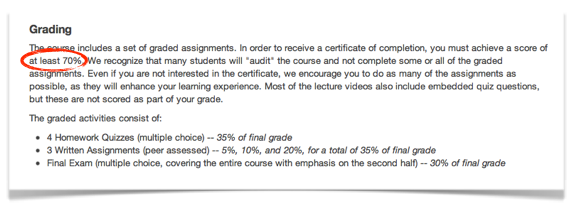
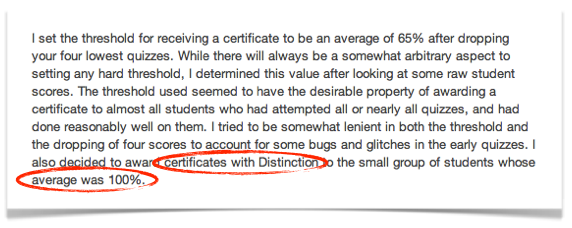

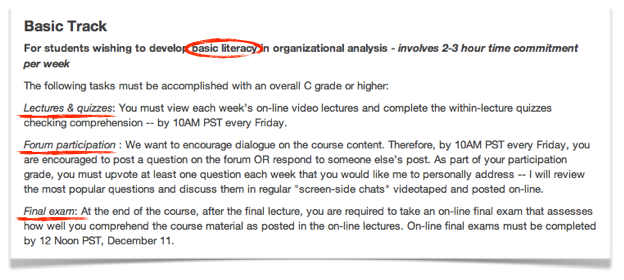
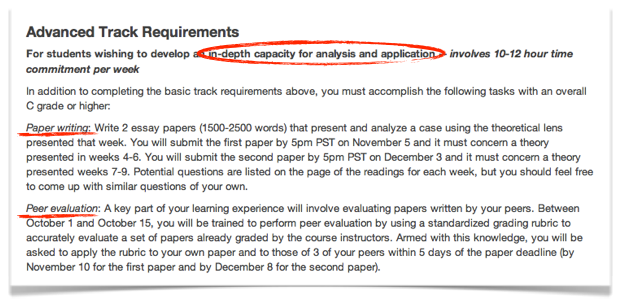



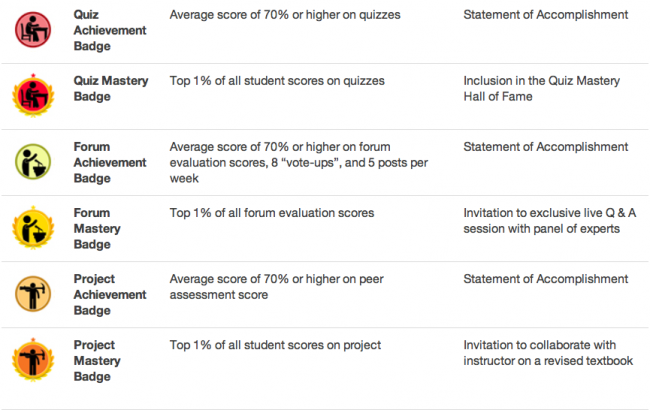

Leave a Response